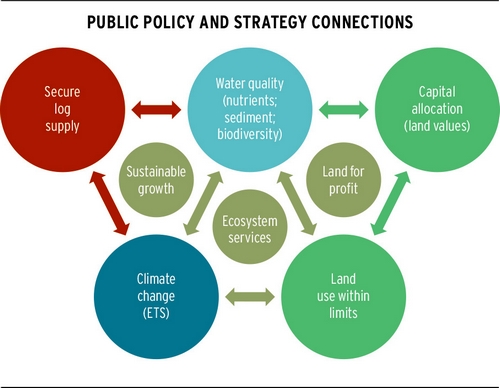Integrated land use holds key to regional development
The Government has completed four Regional Growth Studies – East Coast, Northland, Bay of Plenty and Manawatu-Whanganui. These regions all have significant areas of forestry, which is an important source of local employment. However, there are big differences between the regions in the extent and competitiveness of wood processing mills, transport and other infrastructure. These assets and capabilities are essential to adding more value and jobs from forestry. It is salient too, that Maori own significant land (and forests) in these regions. They are key partners and investors in forest industry development initiatives.
While log supply in these regions is assured for the next decade or so, few new plantings and deforestation in recent years are increasing concern about the availability of logs after 2030 to meet current, and new, processors’ needs.
Alongside forestry development, regional leaders are thinking about how to manage their land and water resources within tighter environmental limits, and how to meet the challenges posed by climate change. The latter includes New Zealand’s commitment to reduce greenhouse gas emissions in 2050 by 50% from 1990 levels and an “intended nationally determined contribution (INDC)” under the new post-2020 International Climate Change Agreement. This agreement is being discussed in Paris as we go to print and aims to achieve a 30% reduction below 2005 levels by 2030 (equivalent to an 11% reduction on 1990 levels).
With this in mind, you quickly appreciate designing regional development plans that will grow household incomes and well-being with a smaller environmental footprint is not a trivial task. Previous regional initiatives; the aforementioned resource and climate constraints; and changing markets all point to the need for a more integrated, cross-sectoral and collaborative approach to regional development than in the past. With traditional rivalry between industries and districts this is easier said than done. It is great, therefore, to see this new approach being fostered in the Bay of Plenty Regional Growth Study Action Plan under the “Bay of Connections” umbrella.
The 2014 National Policy Statement for Freshwater Management (NPS-FM) and the Emissions Trading Scheme (ETS) provide important legislative frameworks for regional growth initiatives. Both policies embody the concepts of ecosystem services (such as flood control, avoided erosion, sequestration of carbon and enhancement of biodiversity) and natural capital. The interdependence between the outcomes sought from the NPS-FM and the ETS, (see illustration) encourage the integration of land uses with complementary environmental impacts, such as forestry and pastoral farming, in order to achieve sustainable land management, better water quality and more resilience to extreme weather. The integration of land uses at various scales has obvious downstream implications for their respective industry value chains and thus regional development.
To understand sector complementarity, a full value chain, multi-sectoral analysis is needed to quantify the benefits and costs of this approach. This broader systems framework is increasingly being used at Scion in our collaborations with regional councils, businesses, iwi and economic development agencies. Because a wide spectrum of science expertise is required from other sectors, including understanding land-owner decision-making behaviour, we are fostering new collaborations with other CRIs, universities and consultants. Recent work in comparing dairy and forestry value chains in central North Island has been particularly insightful on how policy incentives can drive sub-optimal economic and environmental outcomes and, equally, pathways for ‘smarter growth’ with better long-term use of natural resources and less greenhouse emissions.
Regional development is a microcosm of the challenges faced nationally and globally in achieving sustainable economic growth and improved social and cultural outcomes. I am sure the insights Scion is gleaning from several of the growth study regions will be portable and will support an enlarged role for the forest industry in New Zealand’s economic future.
I welcome your views on regional development and any of the other articles in this edition of Scion Connections. On behalf of the Scion Board and staff, I wish you, your families and colleagues our best wishes for Christmas and the New Year.


Dr Warren Parker
Chief Executive
